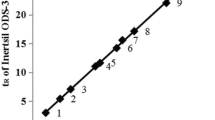Abstract
To establish a standard of quality control and to identify different origins for the Rutaceae family [Citri Unshiu Peel (CU), Citri Unshiu Immature Peel (CI), Ponciri Immature Fructus (PI), Aurantii Immature Fructus (AI), and Aurantii Fructus (AU)], 13 standards including rutin (1), narirutin (2), naringin (3), hesperidin (4), neohesperidin (5), neoponcirin (6), poncirin (7), naringenin (8), isosinensetin (9), sinensetin (10), nobiletin (11), heptamethoxyflavone (12), and tangeretin (13) were determined by high performance liquid chromatography (HPLC)/photo-diode array (PDA) analysis. A YMC ODS C18 (250 × 4.6 mm, 5 µm) column was used and the ratio of mobile phases of water (A) and acetonitrile (B) delivered to the column for gradient elution was applied. This method was fully validated with respect to linearity, accuracy, precision, stability, and robustness. The HPLC/PDA method was applied successfully to quantify 13 major compounds in the extracts of CU, CI, PI, AI, and AU. The pattern recognition analysis combined with LC chromatographic data was performed by repeated analysis of 27 reference samples in the above five Rutaceae oriental medicinal drugs. The established HPLC method was rapid and reliable for quantitative analysis and quality control of multiple components in five Rutaceae species with different origins.



Similar content being viewed by others
References
Cho, S.O., S.P. Homg, H.Y. Choi, H.S. Choi, and J.H. Lee. 2004. Determination methods of Citrus unshii Percarpium by HPLC. The Korea Journal of Herbology 19: 61–66.
Chuang, C.C., C.W. Wu, and J.S. Shuenn. 2007. Origin identification on the commercial samples of Aurantii Fructus. Journal of Separation Science 30: 1235–1241.
Dugo, P., M.L. Presti, M. Ohman, A. Fazio, G. Dugo, and L. Mondello. 2005. Determination of flavonoids in citrus juices by micro-HPLC-ESI/MS. Journal of Separation Science 28: 1149–1156.
Garg, A., S. Garg, L.J. Zaneveld, and A.K. Singla. 2001. Chemistry and pharmacology of the Citrus bioflavonoid hesperidin. Phytotherapy Research 15: 655–669.
Huang, Y.C., and G. Wei. 2008. Establishment and application research for GuangChenPi HPLC gingerprint in identification of medicinal materials. Chinese Traditional and Herbal Drugs 39: 275–277.
Korea Food and Drug Administration. 2011. The Korean herbal pharmacopoeia (K.H.P.). Seoul: Ministry of health family welfare of South Korea.
Korea Food and Drug Administration. 2013. Korean pharmacopoeia part II (K.P. X), 10th ed. Seoul: Shinil Books.
Liang, Y.Y., B. Feng, C.C. Zhu, and N. Chen. 2006. Determination of naringin and hesperidin in Fructus Aurantii Immaturus by HPLC. Traditional Chinese Drug Research and Clinical Pharmacology 17: 359–361.
Liu, X., W.Y. Wu, B.H. Jiang, M. Yang, and D.A. Guo. 2013. Pharmacological tools for the development of traditional Chinese medicine. Trends in Pharmacological Sciences 34: 620–628.
Lu, Y., C. Zhang, P. Bucheli, and D. Wei. 2006. Citrus flavonoids in fruit and traditional Chinese medicinal food ingredients in China. Plant Foods for Human Nutrition 61: 57–65.
Nugroho, A., M.G. Park, S.E. Jin, J.S. Choi, and H.J. Park. 2009. Quantitative analysis of flavanone glycosides and peroxynitrite scavenging effect of the five oriental medicinal drugs (Aurantii nobilis Pericarpium, Citrii unshiu Pericarpium, Citrii unshiu Semen, Aurantii Fructus, Poncirii Fructus). Korean Journal of Pharmacognosy 40: 370–375.
Nugroho, A., S.C. Lim, J.W. Choi, and H.J. Park. 2013. Identification and quantification of the sedative and anticonvulsant flavone glycoside from Chrysanthemum boreale. Archives of Pharmacal Research 36: 51–60.
Peterson, J.J., G.R. Beecher, S.A. Bhagwat, J.T. Dwyer, S.E. Gebhardt, D.B. Haytowitz, and J.M. Holden. 2006. Flavanones in grapefruit, lemons, and limes: A compilation and review of the data from the analytical literature. Journal of Food Composition and Analysis 19: 74–80.
The Pharmacopoeia Commission of the PRC. 2010. Pharmacopoeia of People’s Republic of China (C.P.)., 10th ed. Beijing: Chemical Industry Press.
Xie, Z.J., S.R. Jiao, K. Li, and Y.X. Tong. 2009. Determination of naringin, hesperidin and neohesperidin contention Frutus Aurantii Immaturus from different places by RP-HPLC approach. Journal of XiHua University Natural Science 28: 65–67.
Yan, X.M., M.J. Joo, J.C. Lim, W.K. Whang, S.S. Sim, C. Im, H.R. Kim, S.Y. Lee, I.K. Kim, and U.D. Sohn. 2011. The effect of quercetin-3-O-β-D-glucuronopyranoside on indomethacin-induced gastric damage in rats via induction of mucus secretion and down-regulation of ICAM-1 expression. Archives of Pharmacal Research 34: 1527–1534.
Yi, L.Z., P.S. Xie, Y.Z. Liang, and Y. Zhao. 2004. Studies on fingerprints of pericarpium citri reticulatae viride. Traditional Chinese Drug Research and Clinical Pharmacology 15: 403–406.
Yi, L.Z., P.S. Xie, Y.Z. Liang, Y. Zhao, and H.M. Lu. 2006. HPLC specific (fingerprint) used for quality control of tangerine peel. Chinese Journal of Pharmaceutical Analysis 26: 918–922.
Zhang, S.Z., Y.C. Huang, and G. Wei. 2008. The research of ChenPi HPLC fingerprint. Journal of Chinese Medicinal Materials 31: 217–219.
Acknowledgments
This work was supported by a grant from the National Center for Standardization of Herbal Medicine funded by the Ministry of Food and Drug Safety, Republic of Korea (09112KFDA890), and National Research Foundation of Korea (BK21 Plus; 22A20130000073).
Author information
Authors and Affiliations
Corresponding authors
Rights and permissions
About this article
Cite this article
Zhao, B.T., Kim, E.J., Son, K.H. et al. Quality evaluation and pattern recognition analyses of marker compounds from five medicinal drugs of Rutaceae family by HPLC/PDA. Arch. Pharm. Res. 38, 1512–1520 (2015). https://doi.org/10.1007/s12272-015-0583-x
Received:
Accepted:
Published:
Issue Date:
DOI: https://doi.org/10.1007/s12272-015-0583-x




